Boarding Musics – A lasting Experience
Why are Boarding Musics Important?
Like everything we do daily, traveling is a multisensory experience. However, when we travel, we are usually in a better mood. Our senses are more open to new input, which they can associate with pleasant memories, making the experience richer. Today, we will focus on one reason: hearing and how airlines use it in their brand identity.
How do Companies use Audio?

Photo by Pawel Czerwinski on Unsplash
Let’s take a brief step outside the aviation industry and look at brands in general. The most common brand item is a logo, the central piece of a company’s identity and visually sets it apart. Think of a jingle (a brand sound) as an auditory logo—a quick melody instantaneously associated with a brand. Here’s a classic example.
“Da-da-da-da-da.” Excuse my bad retranscription. This quick succession of sounds is instantly associated with the famous Golden Arches restaurant worldwide. Hearing this sound makes us think of the brand, which, if we are hungry, may lead us to buy a burger.
What is Boarding Music?
Well, we Avgeeks call boarding music the sonic branding of an airline. It’s played during boarding, hence the name, but airlines can use it in other scenarios. Take Air France, for example. They like to spice things up a bit. Here’s their new boarding music.
You will hear it at least once during your experience with the French flag carrier—whether when calling the customer service centre or during your flight. Where AF likes to shake things up is that you may not necessarily hear it during boarding. On my last long-haul flight, it was played during deplaning. But the idea remains the same: they play it so that passengers remember the airline the next time they hear the tune.
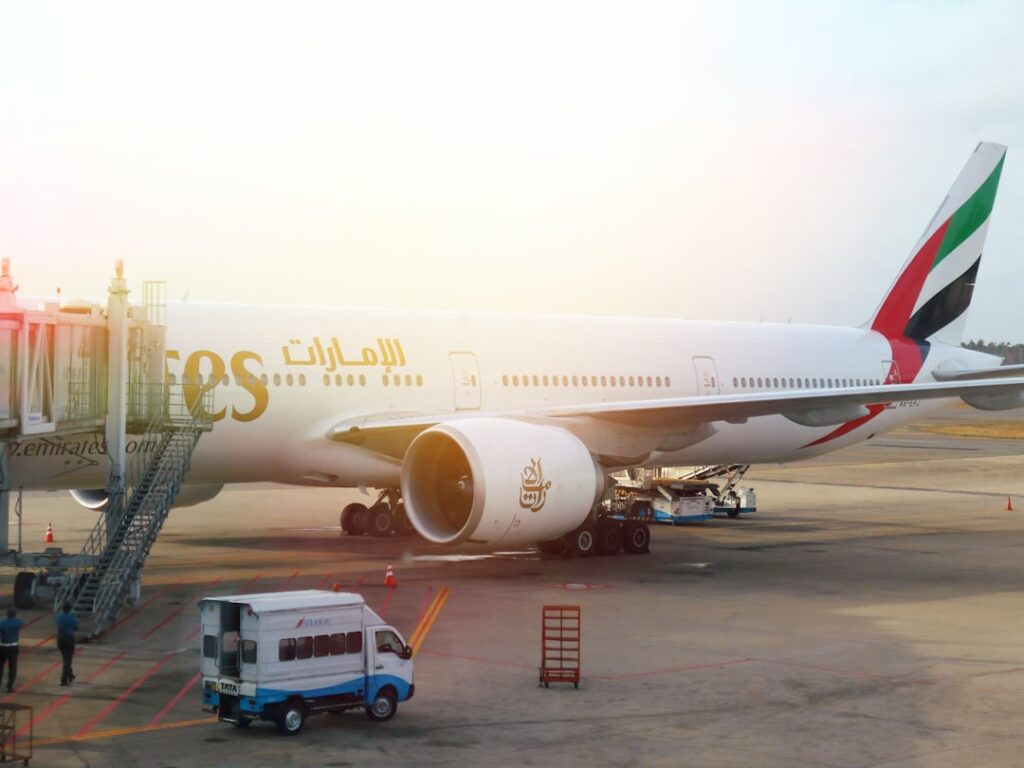
Photo by Adam Marikar on Unsplash
The music is designed to keep passengers calm and relaxed. Most boarding music falls within the category of lounge music without strictly adhering to jazz codes. Some, like Air France, are inspired by electronic music as a nod to the French touch, while others reflect a more global influence. Emirates, for instance, incorporates elements of Native American, Indian, European, and Bossa Nova styles into its iconic boarding music, creating a sonic identity that embodies its worldwide network.
Analysing Emirate’s Boarding Music
Our case study will be the boarding music of the UAE flag carrier, which almost everyone in the industry knows. It was produced in 2012 during the “Hello Tomorrow” advertising campaign. The producer is Christian Saglie, an LA-based film composer.
The song’s first section, from 0:00 to 00:40 in the video, is by far the most recognisable and has been included in every track version since 2012. The version above is the “new” one, which surfaced online around 2015. Christian Saglie originally composed two versions: the “new” version was primarily used in advertisements, while the “old” version was played onboard. However, due to the popularity of the new version, it eventually became the official boarding music for both advertising and in-flight use. For comparison, here’s the old one.
Some Final Thoughts
Boarding music is more than just background noise—it’s a carefully crafted part of an airline’s customer experience, a soundscape that lingers in memory long after the journey ends. It’s not just about branding; it’s about shaping emotions. The right melody sets the mood; It can evoke a sense of place, like Air France’s electronic elegance or Emirates’ global fusion, subtly reminding travellers of where they are—or where they’re about to go. Next time you step on a plane, listen closely. What story is the airline trying to tell you?
Ben’s Blog 2
Good Morning from the city that never sleeps
I arrived here late Saturday afternoon, flying in with Air France’s new Premium service—their revamped take on premium economy. The experience was solid, but as I settled in, I couldn’t help but wonder: What’s the real appeal of this cabin class? Why are so many airlines investing heavily in the premium economy, and what does it mean for the future of business class?

By Delta News Hub – A350: Interior – Premium Select, CC BY 2.0, https://commons.wikimedia.org/w/index.php?curid=63570469
Today, we’ll look at the growing buzz around the premium economy: what’s driving the trend, how it fits into the broader cabin strategy, and why—despite its rise—it probably won’t spell the end of business class just yet.
What is it like to fly “Premium”?
Before we discuss the growing popularity of the premium economy, it’s essential to understand what the experience offers and why travelers are increasingly opting for it.
First of all, there’s personal space—heaps of it. Air France chose to equip its latest A350s (registration F-HUVX) with 32 Collins Aerospace MiQ seats arranged in a 2-4-2 configuration.
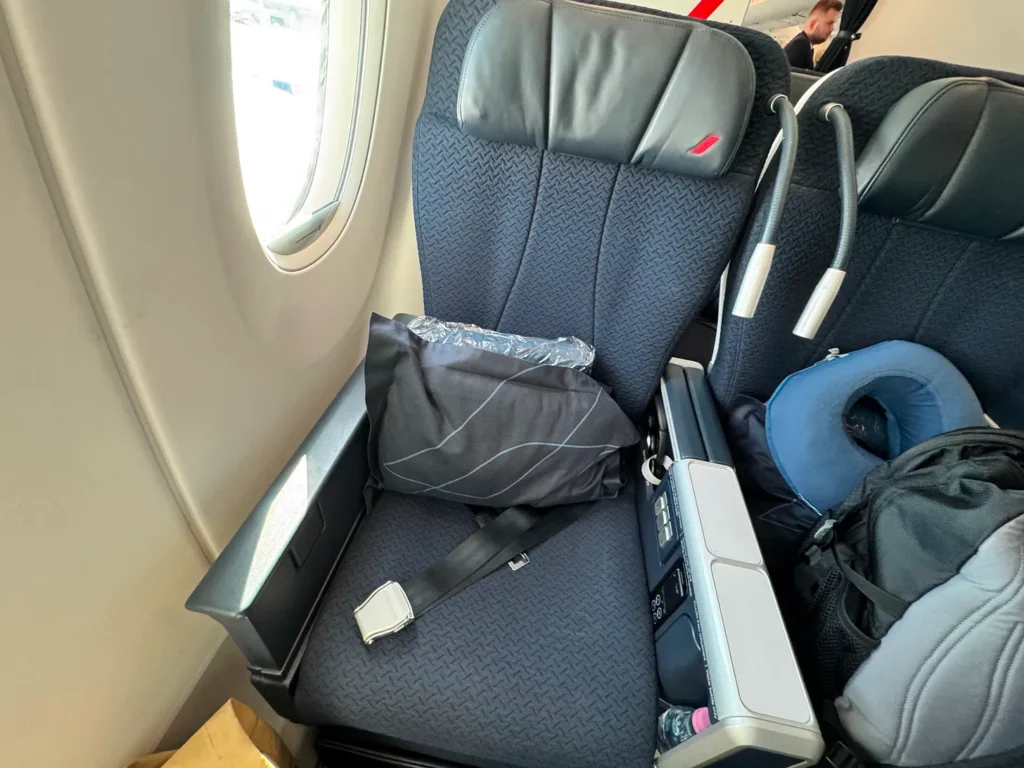
These comfortable seats feature an overhead reading light and one on the side of the seat. The seat itself offers a decent amount of recline, and the footrest can lift, but it will not allow you to lay your feet flat—which, actually, in my opinion, isn’t too comfortable. But in terms of a hard product, it’s the only real downside.
Where a premium economy product truly shines
Well, as you can see, the seat isn’t too different from economy — yes, there’s more space and a few extra bells and whistles, but it’s not exactly something to write home about. Where premium economy shines is in the soft product — in other words, what you get to experience that’s included in your ticket.
Here, airlines get very innovative. JAL, SAS, and ANA give premium economy passengers access to their lounges. Emirates offers an extraordinarily comfortable leather seat paired with a meal close to business class quality. And Kuwait Airways provides a very generous recline thanks to a hard-shell seat design, which means you won’t disturb the person behind you when reclining — yes, that’s technically part of the complex product. Still, it’s so rare that it deserves to be considered part of the soft experience.
Air France does what France is famous for: haute cuisine. They’ve chosen to partner with one-star Michelin chefs for their Premium onboard dining experience — and many of these chefs also hold the title of Meilleur Ouvrier de France, meaning they’ve demonstrated exceptional skill in their craft, particularly in pâtisserie (French dessert pastries).
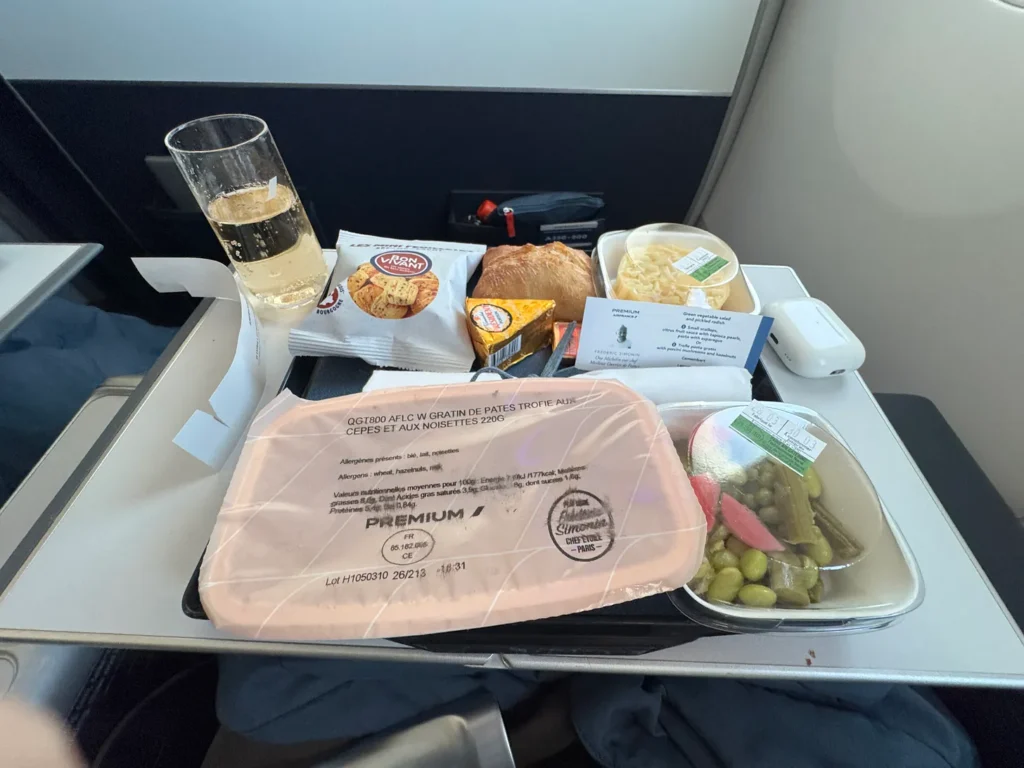

On my flight, I had delicious mushroom pasta paired with an absolutely exquisite lemon pastry—and I usually despise lemons, which says a lot.
The food overall was delicious – I just needed to add a bit of salt, but that’s expected as the pressurization can affect taste buds.
Why are airlines investing in Premium economy?
These past few years have seen more and more airlines invest heavily in their premium economy product. Lufthansa revamped theirs as part of the Allegris programme, Qantas is rolling out an upgraded version for their ultra-long-haul Project Sunrise flights, and Emirates — which never offered premium economy before the early 2020s — is now retrofitting its entire fleet to include a brand-new cabin.
It begs the question: why now?
The answer is simple—the premium economy is the perfect way to target new premium (Business and First Class) customers. It gives them a taste of what the airline does best but leaves them wanting more.
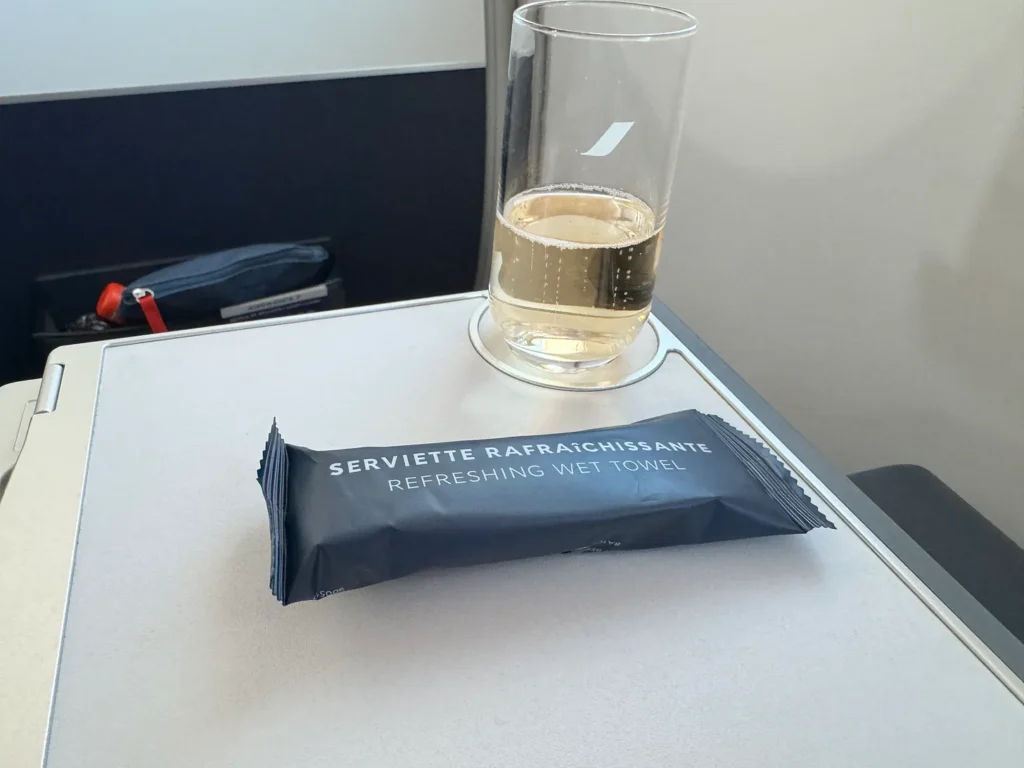
Take Air France as an example. You’re welcomed on board with champagne — the same one served in Business Class — and it’s available throughout the flight. The meal service is nearly on par with what you’d find up front but still presented in an economy-style tray. And since an entry-level Business Class ticket with the airline is often only around 30% more expensive than Premium, the hope is that these customers will return and upgrade. In doing so, the airline wins loyalty and grows its high-yield revenue base.
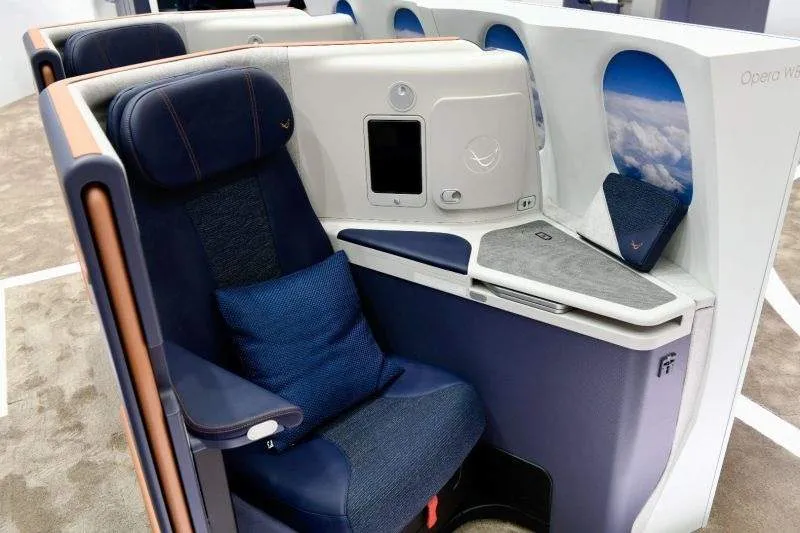
Photo credit: Stelia Aerospace
Since Air France often sells Business “Light” tickets — which come without lounge access, just like Premium Economy — for a similar price (sometimes only 5–10% more than Premium), it makes sense for the customer to try the better options gradually. The airline is betting that passengers will be tempted to jump once they get a taste of the elevated experience. And with the entry-level business class only marginally more expensive, the hope is that these flyers will become loyal, repeat customers, bringing in more high-yield revenue over time. PE is, therefore, the ideal testing ground.
Is premium economy a threat to business class?
Not quite. It’s a complement, not a competitor — a stepping stone that introduces travelers to the premium experience without cannibalizing the upper cabin. As long as Business continues to offer true differentiation — lie-flat seats, complete privacy, and top-tier service — it will remain the gold standard for high-value travel.
Ben’s Blog 3
The world’s most youthful airline?
What is it like to fly Virgin Atlantic in Economy class
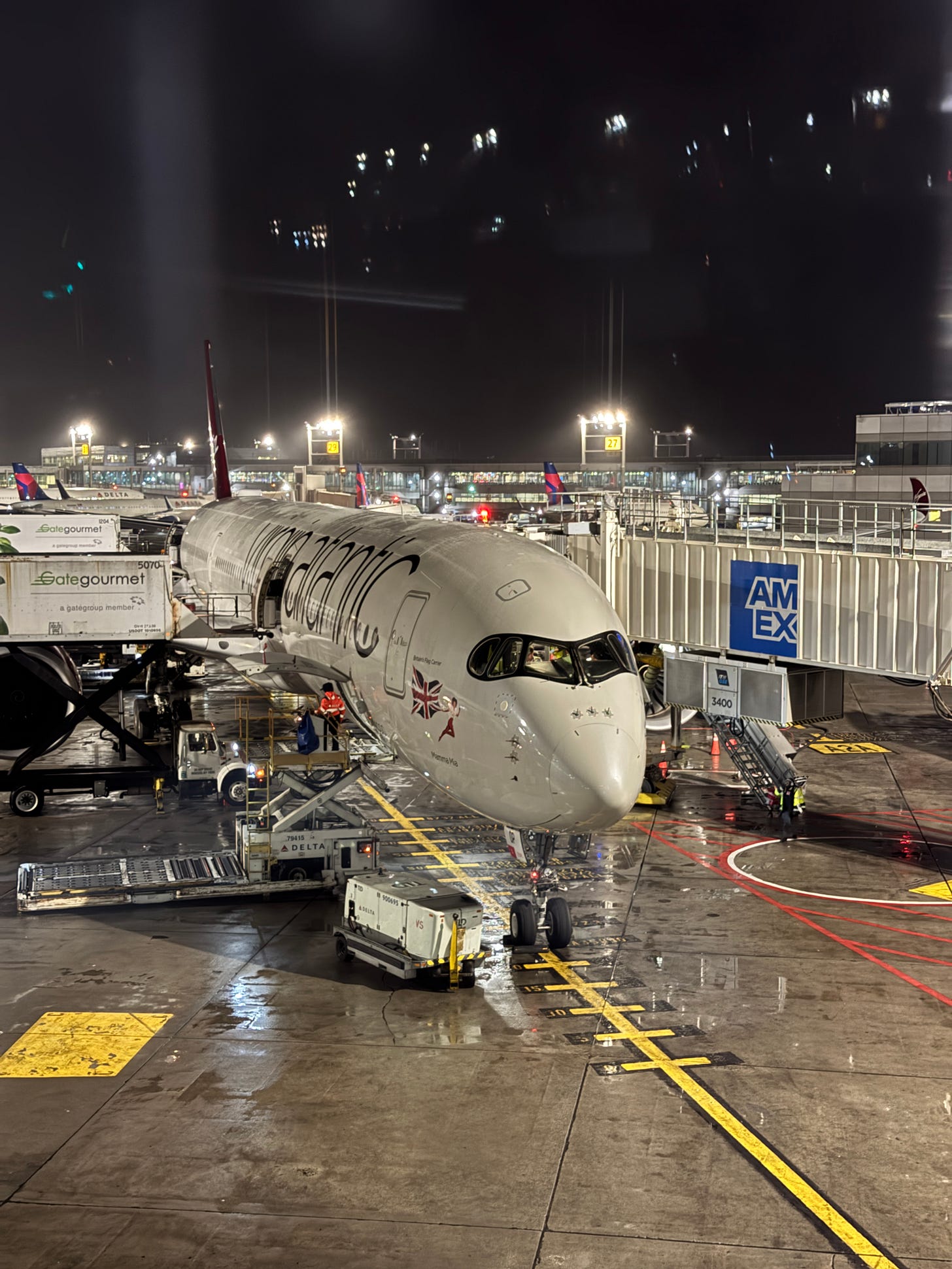
Ah, Virgin, the brainchild of Sir Richard Branson – it began as the go-to place to buy records and books in the UK. Since 1984, it has expanded into air services. So, just how Virgin-like is VS? Let’s find out.
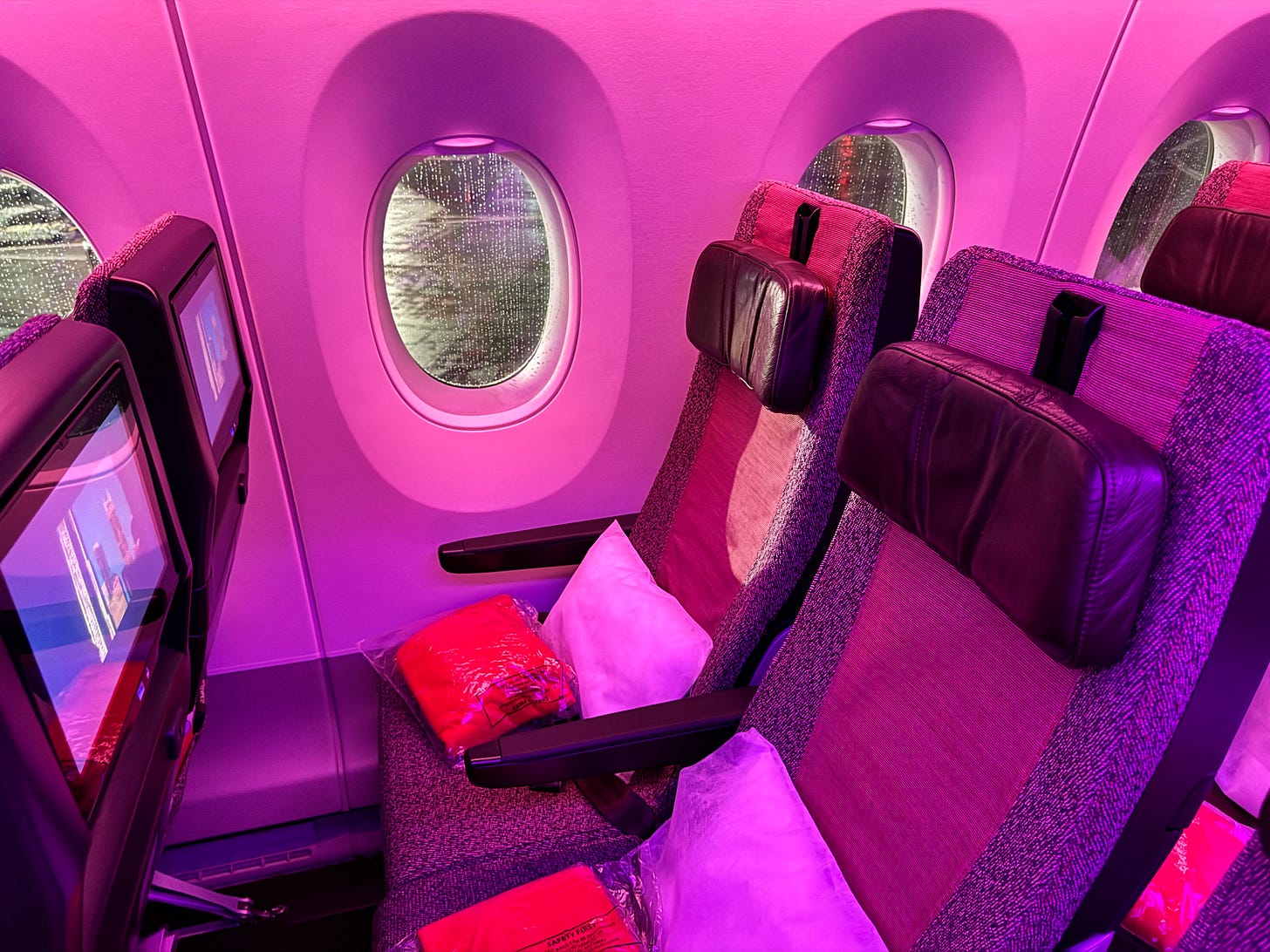
Upon boarding, you are greeted with a very eye-catching cabin. As I benefit from preboarding, I got to observe the environment around me. The purple/pink mood lighting can make you feel a bit dizzy at first if you’re not expecting it, but it gives a very joyful atmosphere. Over the tannoy, top-of-the-charts pop songs, which, if you know the history of the Virgin brand, is a nice wink to its inception.
The choice of seats and IFE
The seat itself resembles a modification of the Recaro CL3710 seat (it probably is), which is a bestseller featured on many long-haul airlines, including Qatar Airways, Singapore Airlines, and even rival British Airways. It’s very comfortable. However, there was one issue – the IFE screen malfunctioned.
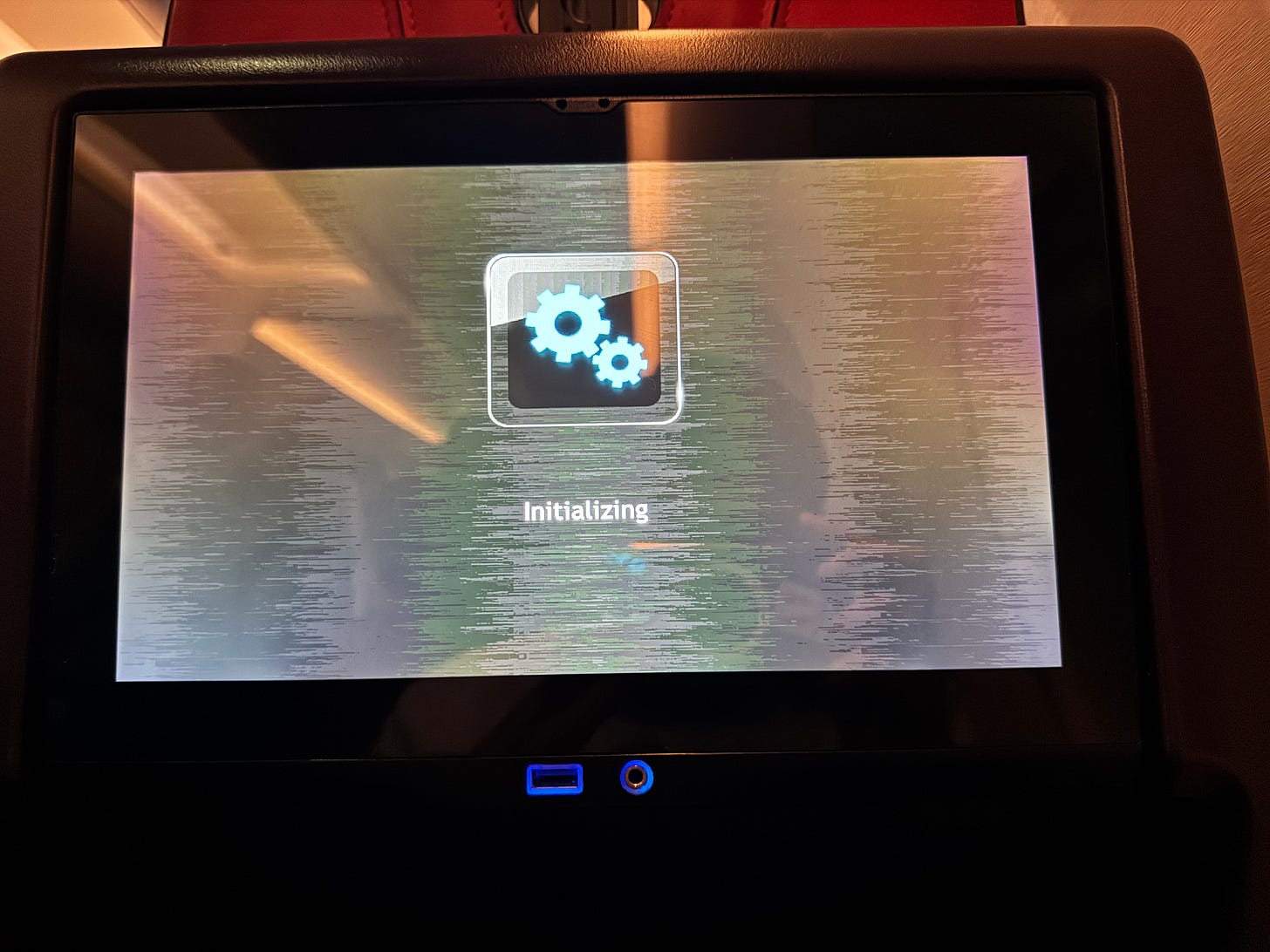
Yeah, not great. But it was a night flight, so I spent most of the time sleeping. What did work, however, is a feature Airbus has become known for on long-haul sectors: their exterior cameras.

It made for absolutely breathtaking views during the descent over the Irish Channel as the sun rose.
Let’s dig in
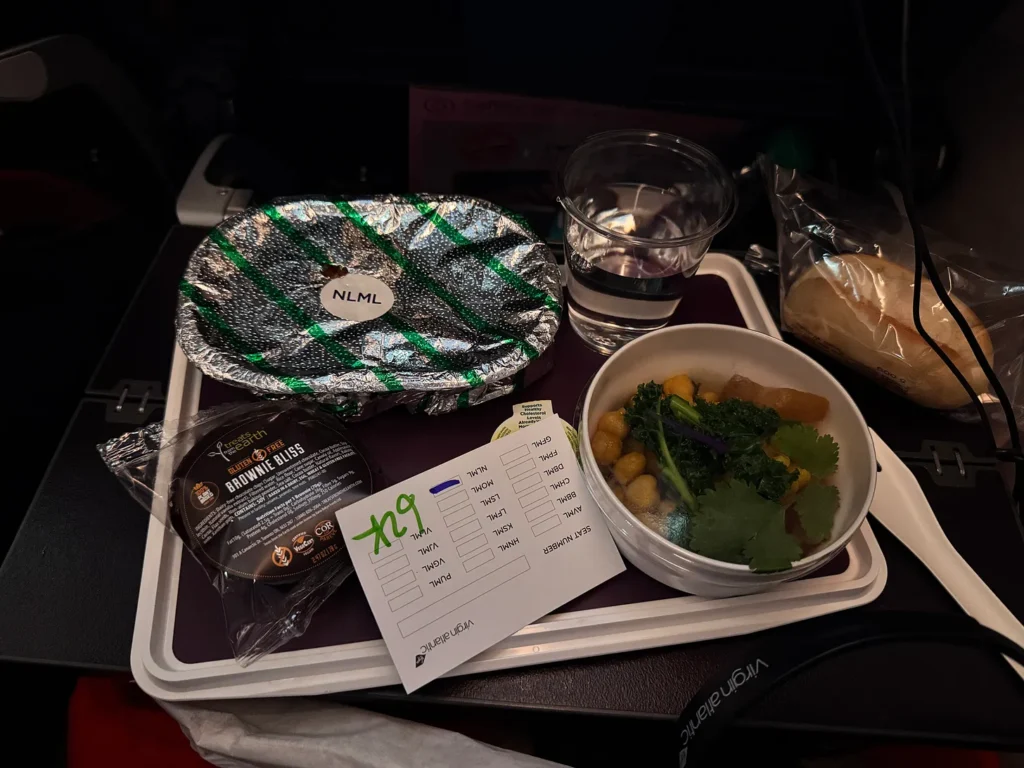
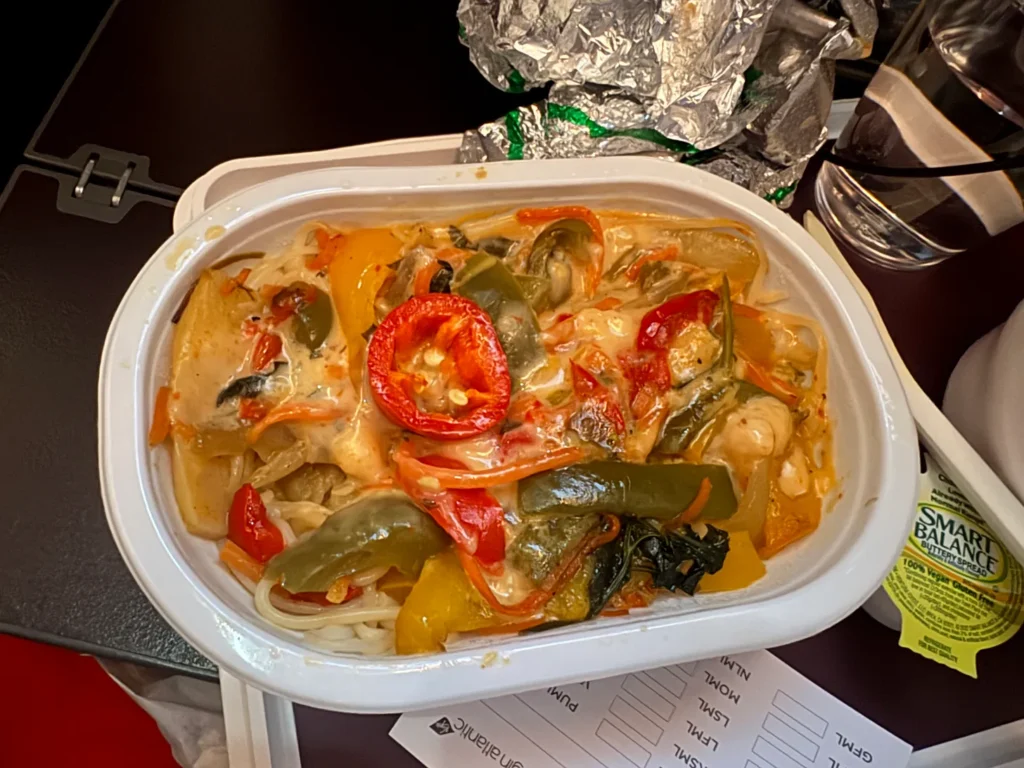
Another positive was the food, specifically an Asian-American pasta dish. Although it was a bit spicy, it was the best special meal I’ve had (I ordered a dairy-free option) – it’s usually a weak spot for airlines.
Virgin, yay or nay?
As I mostly slept and enjoyed the views, there’s not much else to report on the actual flight. However, the crew was so friendly; they went beyond trying to fix my seat, offering me another one instead. I declined, as I wanted the window seat.
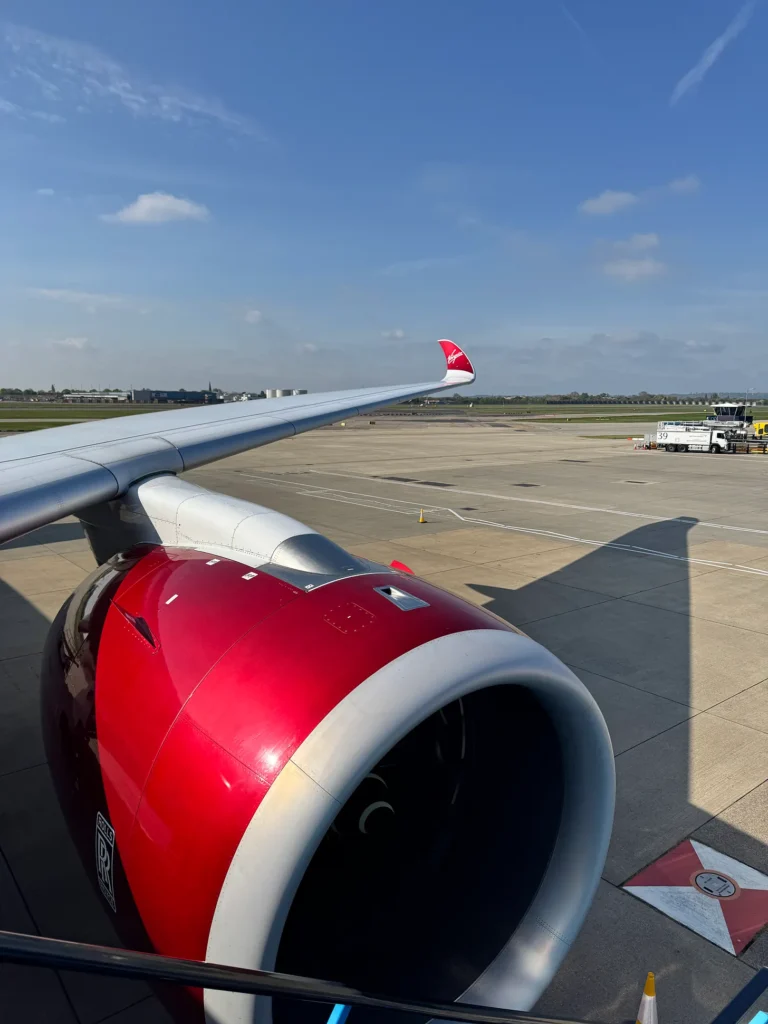
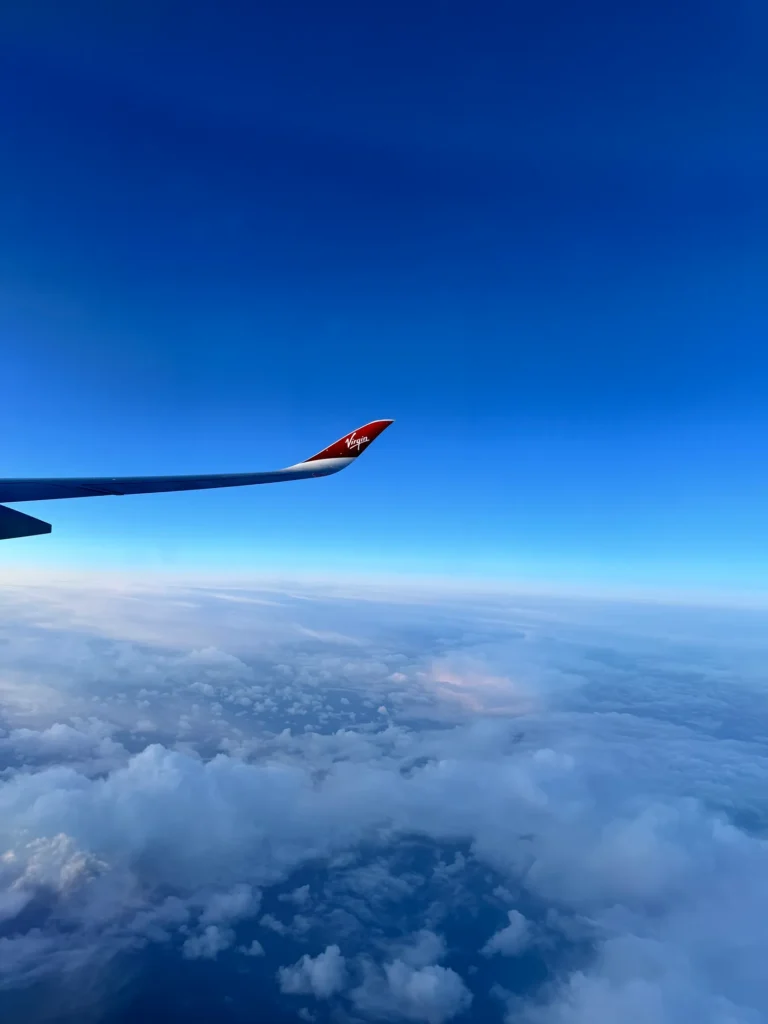
So, do I recommend it? It depends on whether you’re traveling with children in their teenage years or as a young couple. The brand likely corresponds to you, and their fares can be affordable. If you’re a businessman, it may be a bit OTT (though I’ve been told the business class is a different story).
In any case, over 40 years of service, VS has remained true to the Virgin way of doing things, which I admire.
Ben’s Blog 4
We need to make flying more fun in economy class
It’s time to reflect on 50 flights in economy
In 2024, I flew 54 times—around 50 of those in Economy class, the cabin where most of the world flies. And yet, despite being the heart of the passenger experience, Economy is too often treated as an afterthought. Only a select few airlines have mastered the art of making the back of the plane feel like more than just a seat.

Analysing profit in Y class
In one of my earlier posts, I highlighted how airlines use clever marketing touches throughout the flying experience, such as placing their logo on wingtip devices, subtly reinforcing brand identity even during mid-flight.
But here’s the next step: integrating that same branding mindset into the actual product, especially in Economy class. Let’s analyse the cabin of Virgin Atlantic, which I recently flew.
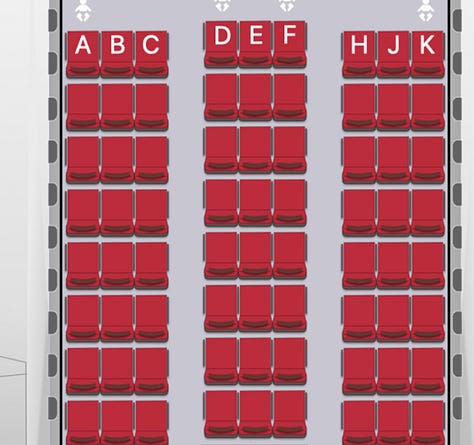
This aircraft has 235 seats in Economy class. At an average fare of €235 per passenger, which aligns with what I paid, that’s €55,225 in gross ticket revenue from Economy alone.

How can an airline improve the economy class experience while staying true to its brand?
Let’s go back to my analysis: once you account for fuel, crew, catering, maintenance, landing fees, and overhead, the typical operating cost per Economy passenger can range from €120 to €150 on a short to medium-haul flight. Using a mid-range estimate of €135 per passenger, the total operating cost for Economy is approximately €31,725.
That still leaves the airline with an estimated €23,500 in contribution margin, just from Economy class. And that’s on a flight many would call “standard” – it’s pretty good, but there are ways to improve. Let’s see what we can do.
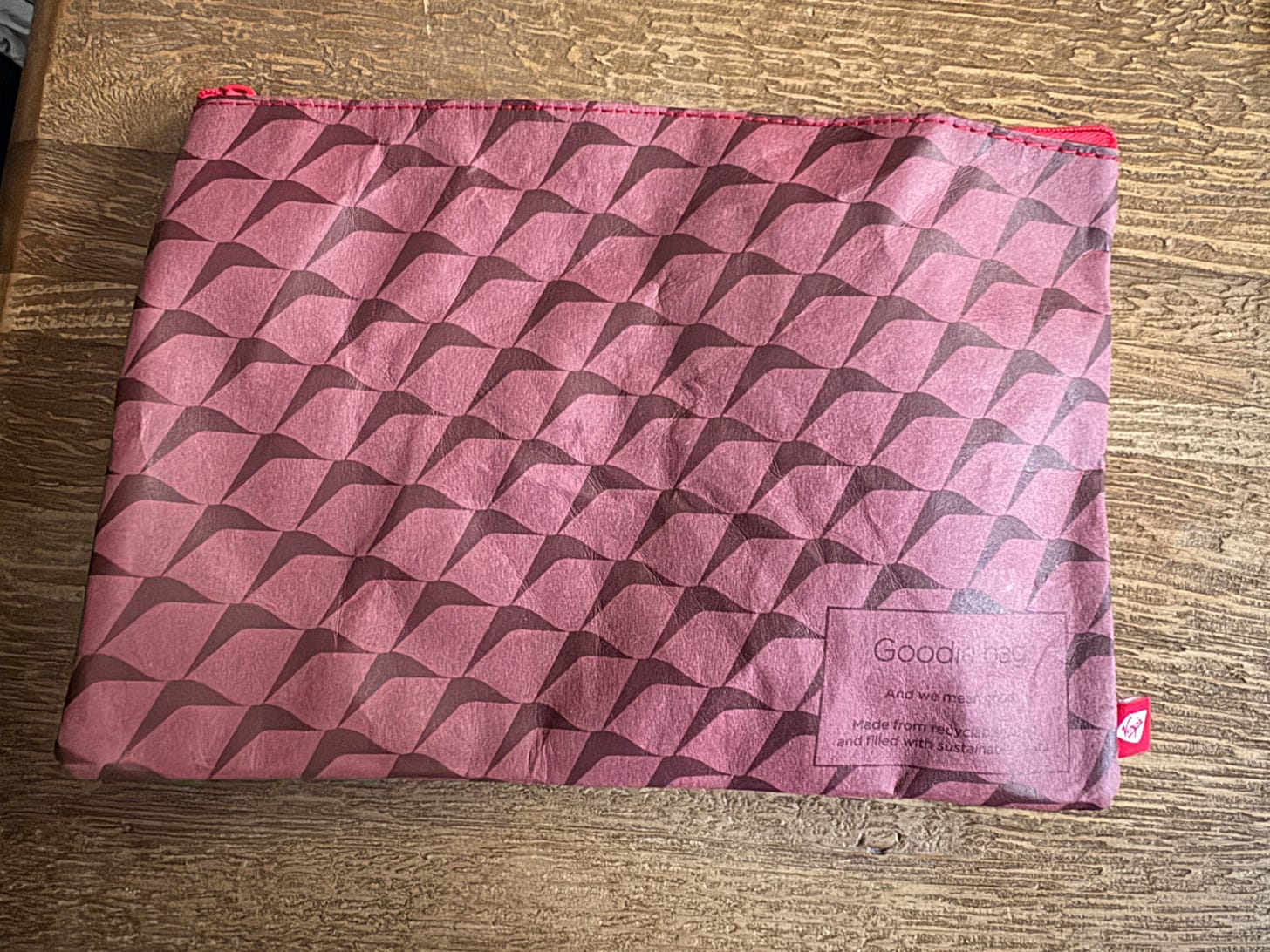
The amenity kit you see here is standard in Business Class: an eye mask, socks, skincare products, a toothbrush, and toothpaste — small touches that quietly reinforce comfort, care, and attention to detail. Now, imagine adapting this concept to Economy class.
The first step? Don’t just ask what we can afford to give? — Ask what our brand stands for?
Let’s say the brand is fun, family-oriented, and accessible. That immediately changes the brief. Creams and luxury items? Not essential. Instead, why not create moments of delight that reflect your passengers and destinations?
For children: a mini kit with a pack of Top Trumps cards, a playful eye mask, and a simple activity booklet.
For adults: a humorous eye mask — something that adds a light hearted touch to the journey and maybe even earns a few smiles.
For leisure travellers: tailor the kit to their destination.
- Flying to the Caribbean? Include a travel-size sunscreen.
- Arriving in a major city? A pair of earplugs and a small card with local tips or transit info can add real value.
This isn’t just about amenities — it’s about using physical touchpoints to express brand identity, spark positive emotions, and leave a lasting impression in the part of the plane most passengers experience. Economy class isn’t just a seat. It’s an opportunity.
Could airlines feasibly do this marketing stunt?

On a typical flight with 235 Economy passengers, a brand-aligned amenity kit program could be introduced at a modest cost. Assuming 15% of travellers are children, and the rest are split evenly between sunny and urban leisure destinations, the total cost of offering tailored kits, including items such as Top Trumps cards, humorous eye masks, earplugs, or sunscreen, would amount to just €251.25. This represents a minimal deduction from the estimated €23,500 contribution margin, leaving approximately €23,248.75. For barely more than €1 per passenger, the airline can significantly enhance its brand perception and passenger experience, reinforcing its identity where it matters most: in the cabin, where most people fly.
Why should airlines do it?

At the Apple Store, customers are encouraged to touch, try, and interact with the products. Why? Because physical interaction increases the likelihood of purchase.
The same principle applies to airlines.
When passengers engage with a physical expression of your brand — even something as small as an amenity kit — it creates a tangible connection. And when that item feels like a free gesture of goodwill, rather than something built into the ticket price, it leaves a lasting impression.
These touchpoints matter. They turn a routine flight into a branded experience — and ultimately increase the likelihood that a customer will fly with you again. The more passengers interact with your brand physically, the more emotionally invested they become. In a highly competitive market like long-haul travel, emotional connection drives repeat business.
Food, a way to travel with your pallet

With 557 passengers in Economy and an average one-way fare of €483, I estimate Emirates generates approximately €129,781 in contribution margin per Europe-bound A380 flight. That’s before factoring in onboard extras, such as amenity kits or meals.
Now, consider the catering experience. On my recent flight out of Paris, dinner consisted of a hearty beef bourguignon accompanied by a glass of Sauvignon Blanc, followed by a cheesy bread served as breakfast before landing in Dubai. Assuming decent-quality, mass-produced components, the total catering cost per passenger amounts to approximately €7.50, or €4,178 for the entire cabin. Leaves a pretty big margin.
How can airlines make meals better?
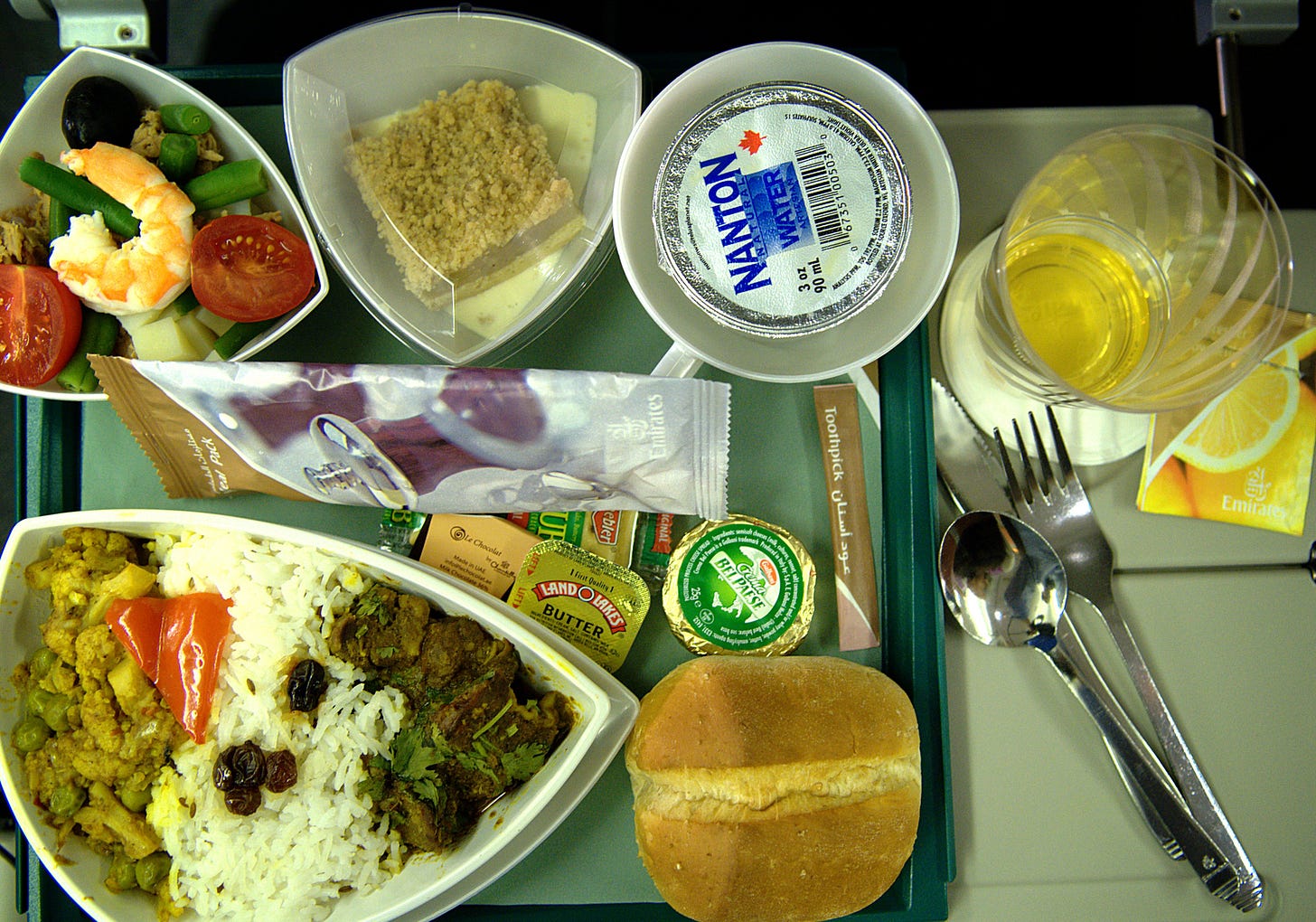
Let’s imagine I’ve acquired a second-hand A380 from Emirates and configured it with a similar high-density layout — 557 seats in Economy. But unlike Emirates, I’m based in France and flying to the Middle East. So, how do I create an Economy experience that convinces passengers to choose me instead?
The answer: local identity and emotional connection.
Instead of generic airline meals, I partner with regional producers to offer a distinctly French onboard experience. Each passenger, assuming no dietary restrictions, receives:
- One slice of locally sourced Brie de Meaux
- A small glass of Alsace Riesling
- A warm Ficelle Picarde, a savoury crêpe from northern France, not far from CDG
- A Paris-Brest, a locally made pastry for dessert
Every detail — the tray, glass, lid, and even the napkin — carries the airline’s branding, reinforcing the experience as thoughtfully curated, not mass-produced.
The cost? Roughly 9.40 per passenger, or €5,235.80 for the entire Economy cabin. Even after this is deducted from an estimated €124,545.20, a substantial margin remains, accompanied by an elevated product offering.
Changing economy class is within reach

On a flight with 235 passengers paying €235 each, the airline earns approximately €23,500 in margin after covering operating costs. For just €1 per passenger, a tailored amenity kit adds personality and value without significantly impacting profits. On a larger A380 with 557 seats, even a premium French meal with wine and dessert costs just €9.40 per person, leaving the airline with over €124,500 in profit.
These aren’t just extras — they’re brand touchpoints. A playful eye mask, a slice of Brie de Meaux, a card game for kids — small things that create emotional connection, enhance loyalty, and set your airline apart. In a competitive market, fun isn’t frivolous — it’s a strategic advantage.
Ben’s Blog 5
The low-cost long-haul revolution?
I think it’s about time to revisit the A321XLR
If you’ve been following the blog for a while, you might remember my recent post about the A321XLR and the broader topic of long-haul narrowbody aircraft. That post came to mind again recently after I flew on a Wizz Air A321neo. The experience made me reflect on the airline’s ambitious plans to launch long-haul routes using the A321XLR, including potential flights from London to Medina and Riyadh. Let’s examine why the XLR could be the way to solve the Long-haul LCC enigma.
Kings of Point to Point

Low-cost airlines thrive on the point-to-point model, meaning you can fly between two cities without connecting. This allows them to use their aircraft more efficiently, reduce turnaround times, and avoid the high operating costs associated with congested hub airports.
Look at the airline above – Ryanair. Name any two major European cities, and it is almost guaranteed that they will have a route linking them.

Now let’s take a look at the A321. Although it’s part of Airbus’s short-haul family, its size and range make it incredibly versatile. It is designed to operate efficiently from smaller airports with shorter runways and is ideal for point-to-point carriers like Wizz Air. That’s why Wizz loves it — you can carry more passengers on the same kinds of routes served by Ryanair, but without the complexity or cost of operating a widebody. It also allows Wizz to use lower-cost secondary airports like Beauvais, flying to popular destinations for their customer base, such as Bucharest or Budapest.
It’s already tried and tested
The A321XLR boasts the most extended range of any commercial narrowbody aircraft, excluding modified business jets like the ACJ and BBJ series designed for ultra-wealthy individuals or heads of state. However, it’s not the first A321 variant adapted for long-haul operations.

The A321LR has been in service for nearly half a decade and has already proven its value, particularly on routes connecting secondary cities. Its success has demonstrated the viability of long-range narrowbodies, paving the way for the XLR to take that concept even further. JetBlue and Air Transat are good examples, which use the type on transatlantic flights to secondary European cities like Edinburgh or Dublin.
Wizz – the next long-haul giant?
As it turns out, Wizz Air is already testing the waters of medium- to long-haul operations with its newly delivered A321LRs. One example is the route from Paris Beauvais (BVA) to Kutaisi, Georgia — a flight that, depending on the season and wind conditions, can take anywhere from 4 to 5 hours on the return leg.
Wizz Air also has A321XLRs on order, and if the LR is already proving successful, the XLR could become a genuine cash cow for the airline. In the ultra-low-cost sector, passengers typically aren’t concerned about the lack of in-flight entertainment or gourmet meals. Most bring a backpack, a fully charged phone with a battery pack, and their favourite shows already downloaded, making comfort trade-offs more acceptable in exchange for low fares and direct routes.
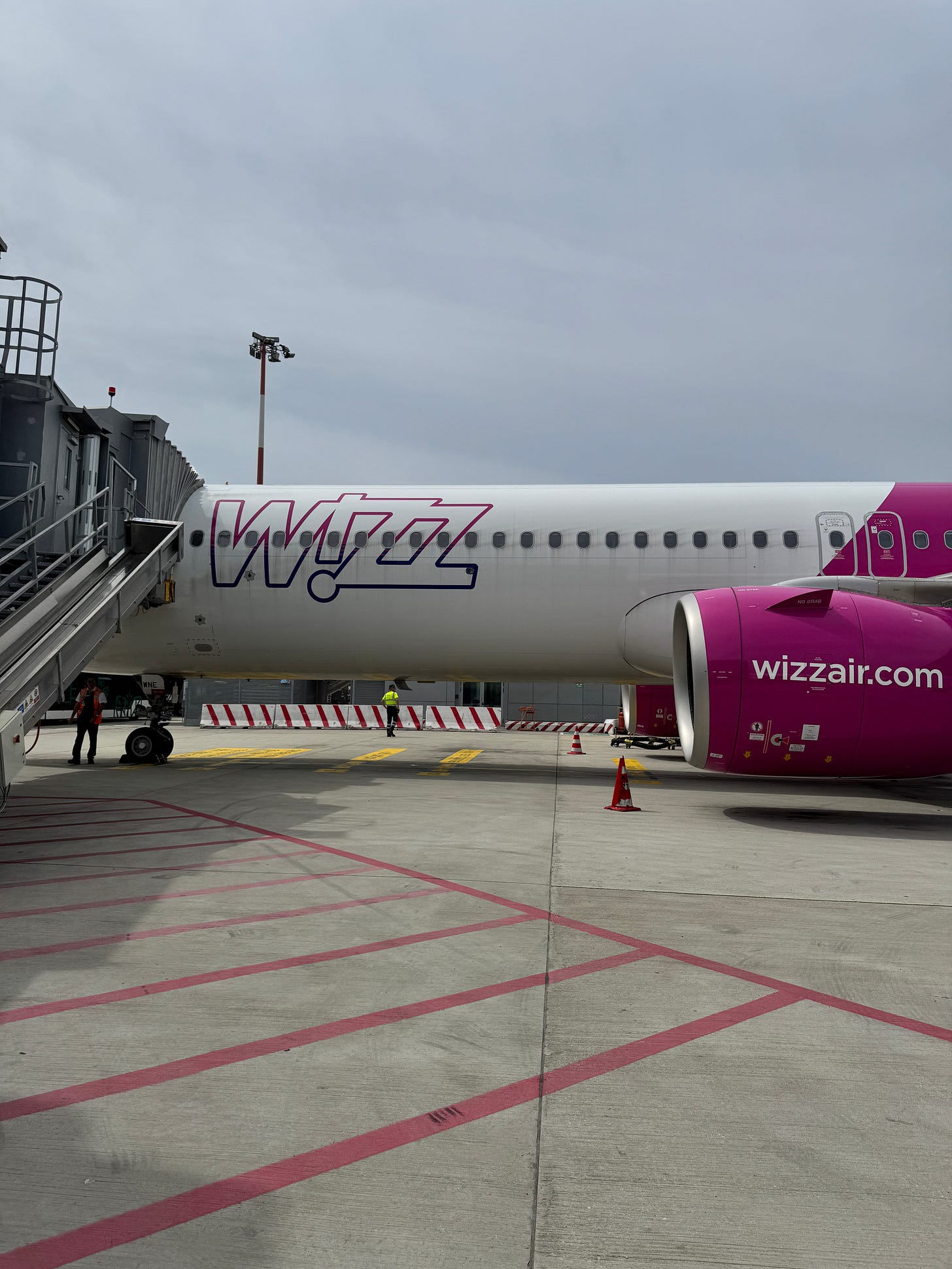
Why did others fail in the sector?
In my view, many airlines that have tried to make long-haul travel more affordable have done so by mimicking traditional full-service carriers with lower prices as if by magic. They often include features like in-flight entertainment, but not always for free: on one airline, you might watch your favourite movie at no cost, while on another, you’ll need to pay 8€ for a “Hollywood pack.” This inconsistency can be frustrating for passengers and, more importantly, drives up fuel consumption and maintenance costs for the airline due to heavier and more complex cabin systems.
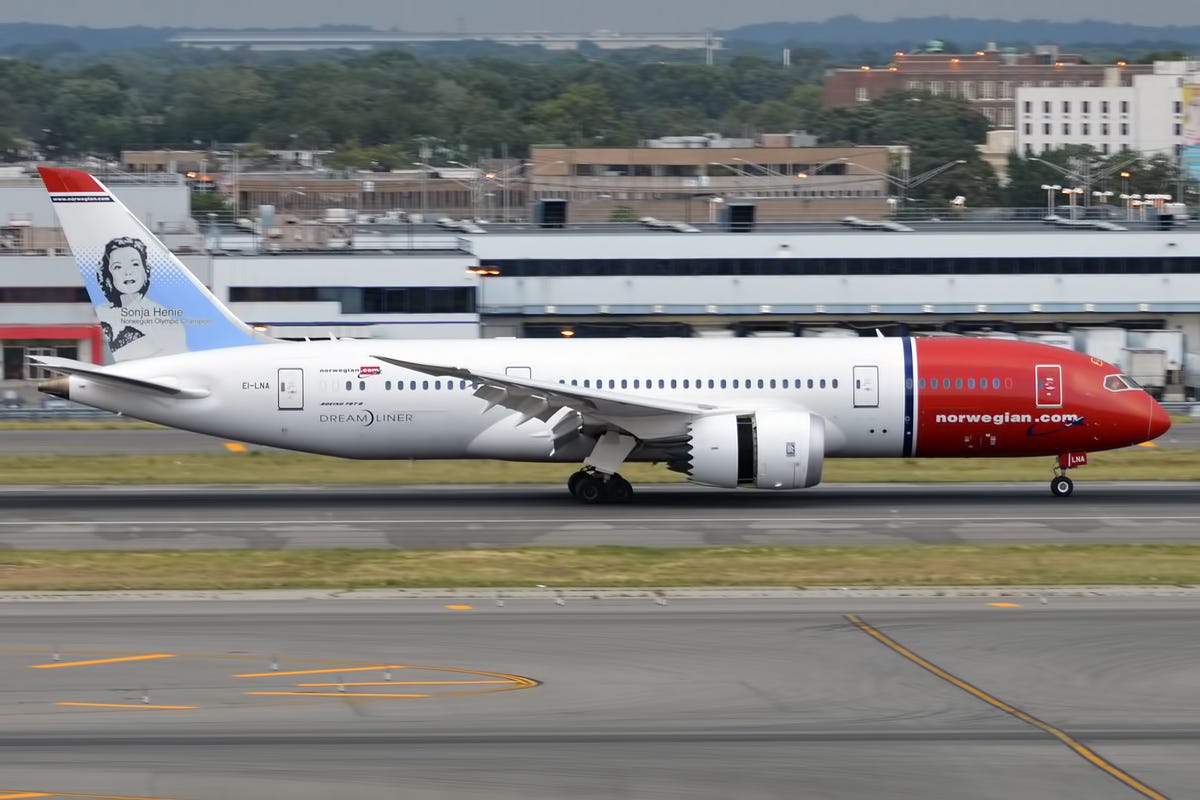
A telling example is Norwegian Long Haul. While they offered competitive fares, their product lacked consistency — unlike Air Transat or French Bee, they didn’t offer free in-flight entertainment. Despite being a low-cost carrier, they operated a large and expensive fleet of Boeing 787 Dreamliners and maintained multiple international cabin crew bases. The real issue, however, was strategic: they attempted to manage the Boeing 787s with the same mindset and cost structure as their short-haul Boeing 737s, a model that didn’t scale for long-haul operations.

While Wizz Air has faced delays in receiving its A321XLRs, the aircraft is still expected to enter service imminently. When it does, it will benefit from the proven European low-cost model: quick turnarounds, point-to-point flying, and a vast network of international crew bases. This approach enables Wizz to maximise aircraft utilisation, which ultimately drives down operating costs. A typical day for an airframe might involve routing from Paris to Riyadh, then onward to Abu Dhabi and Milan, with two crew changes along the way.
By structuring operations so crews can legally complete return segments on each leg (e.g., BVA–RUH, RUH–AUH, AUH–MXP), the airline avoids the added expense of layovers and reserve crews. The only significant challenge to this model would be flights to North America, where time zone shifts complicate legal duty limits, but that doesn’t appear to be part of Wizz Air’s current strategic focus.
Bottom Line
The Airbus A321XLR could be a game-changer for long-haul low-cost travel in Europe and globally. Its range — the longest of any standard-production narrowbody — allows it to reach deep into markets previously only accessible by widebody aircraft. What makes it revolutionary is how easily it fits into the operational model perfected by European low-cost carriers: quick turnarounds, point-to-point flying, high aircraft utilisation, and a network of international crew bases. This lean, decentralised model keeps costs down and opens the door to sustainable long-haul routes from secondary airports, bypassing the expensive hub-and-spoke systems of legacy carriers.
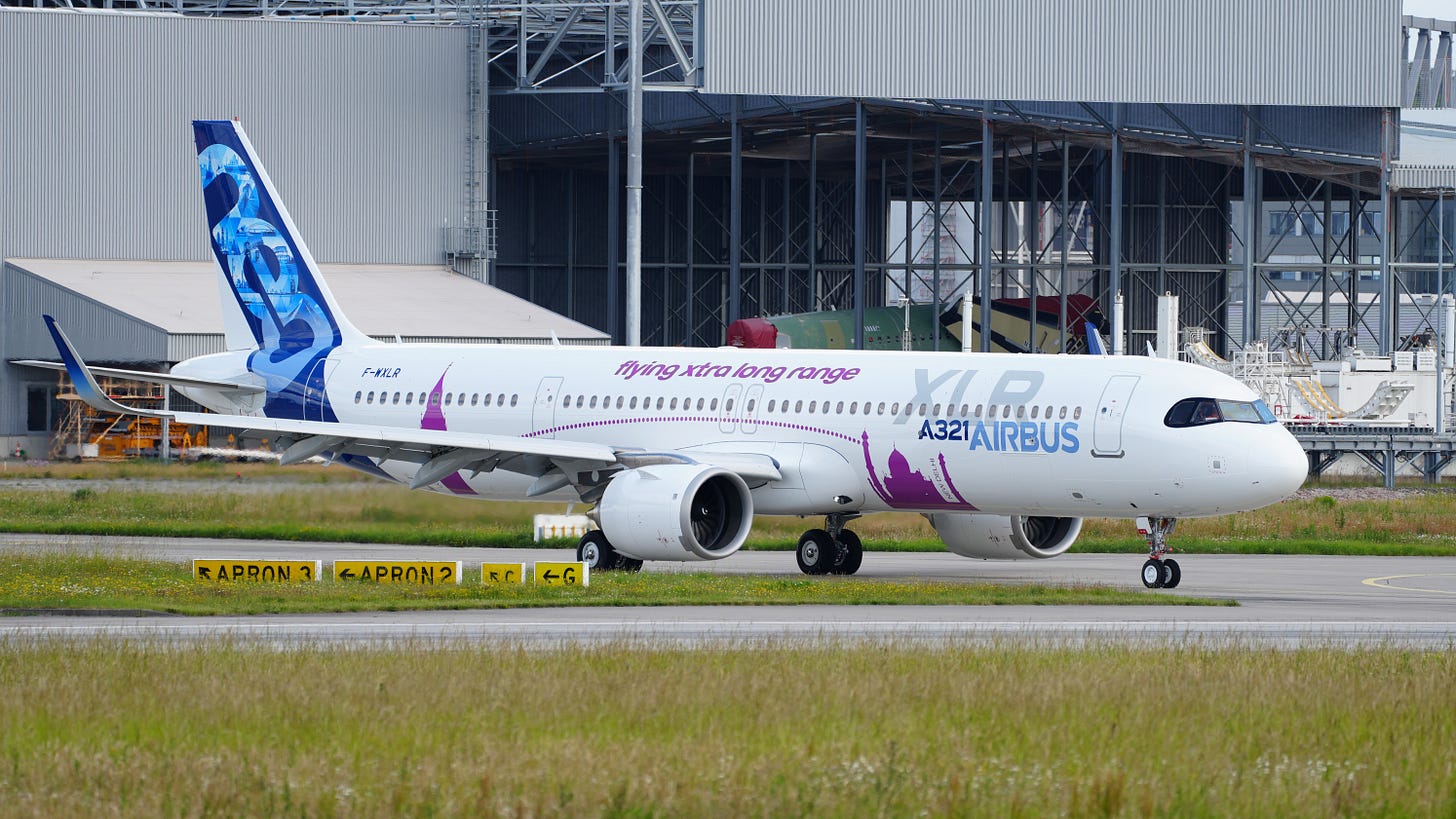
Where other low-cost long-haul experiments struggled by mimicking full-service models with widebodies and added frills, the XLR allows airlines to stay true to a no-nonsense approach. Passengers today are used to flying with a backpack, their phone, and pre-downloaded content — they don’t expect luxury, just affordability and efficiency. Whether flying from Paris to Riyadh, Madrid to Boston, or Kuala Lumpur to Sydney, the XLR makes long-haul LCCS viable by stripping back complexity and leveraging a proven model on short- and mid-haul routes. It’s not just a plane; it’s a platform for global expansion.